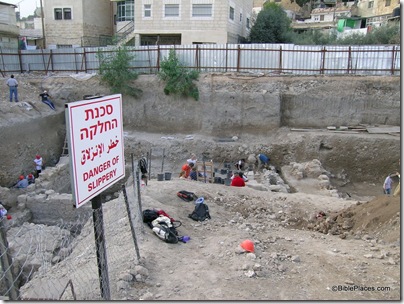Brian Janeway has just posted a review of last year’s ASOR meetings in an article entitled “Biblical Archaeology in 2010: Going Strong Still!” If you missed the meetings or just would like a review, start here.
Eight papers were given on Khirbet Qeiyafa, the 10th century site next to the Elah Valley.
Khirbet Qeiyafa is the only known fortified city in Judah dated to the time span from the end of the 11th century to the beginning of the 10th century BC. The excavated pottery places the site in Iron IIA period and includes finger-stamped jar handles, ‘pre-LMLK’ jars, and late Philistine decorated pottery known as ‘Ashdod Ware.’ Petrographic analysis shows that the Philistine vessels were not made locally and were probably imported to the site. Dr. Aren Maeir, director of the excavations at nearby Tel es-Safi/Gath confirmed during the response period that the pottery assemblage was definitely not Philistine. Interesting comments were also offered by Bill Dever and John Holladay, both of whom compared the Qeiyafa pottery assemblage to Gezer 8 below the Solomonic Gate and Jane Cahill believes it parallels material found in Jerusalem above the stepped-stone structure at a time that coincides with an expansion of the city. Ron Tappy spoke about a new early 10th century phase found at Tell Zayit that predates the famous abecedary inscription.
The Elah Valley was the scene of the battle of David and Goliath, and this was the subject of another paper:
Another interesting presentation was given by Jeffrey Zorn of Cornell University entitled “Reconsidering Goliath: An Iron I Philistine Maryannu.” In it he revises the idea that Goliath was an infantry soldier through a textual analysis of his weaponry and accoutrements. Zorn asserts that the fish scale body armor, probably attached to an underlying tunic, bronze greaves, which are only found in Mycenaean Greek contexts c. 1200 BC, and his being accompanied by a shield-bearer, all point toward Goliath being a maryannu. Maryannu is a Hurrian term for an elite warrior who fought on chariots, usually alongside two attendants, as attested in Egyptian depictions at Medinet Habu of 3-man Egyptian and Hittite teams fighting at the Battle of Kadesh (c. 1275 BC).
Janeway reviews other presentations, but I’ll excerpt only one more.
“Hebrew Bible, History, and Archaeology” featured papers by Anson Rainey, who made the case for identifying biblical Ziklag at Tell Sera’, based on biblical and medieval texts and Jeffrey Hudon of Andrews University, who proposed that the now famous LMLK storage jar seals had a longer period of production and use that originated during the reign of King Uzziah in the late 8th century and not to the later Hezekiah. The circumstances in 2 Chron 26:9-10 in its description of royal estates and viticulture occur in the same regions as the stamps have been found. They served as important royal symbols of the Judahite kingdom. These estates were established all across the kingdom from ‘En Gedi to the Shephelah and were the functional explanation for the LMLK stamps according to another paper by Hayah Katz of The Open University of Israel.
The full article is here.
